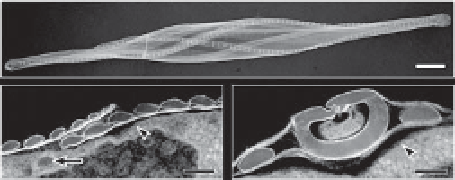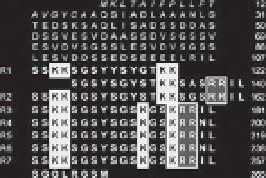Biomedical Engineering Reference
In-Depth Information
(
a
)
(
b
)
(
c
)
400
CH
3
CH
3
CH
3
CH
3
CH
3
CH
3
+
HOOC
N
N
N
NH
3
(m+H)*=573
NNN
244
315
386
457
NH
2
300
CH
3
CH
3
N
CH
3
N
CH
3
N
CH
3
N
CH
3
NH
2
N
N
200
86
157
228
299
NH
3
+
100
(
d
)
H
2
N Ser Ser
Lys Lys
Ser
Gly
Ser Tyr CO
2
H
H
OH
OH
OH
OH
N
N
OH
0
CH
3
CH
3
CH
3
CH
3
N
3
4
5
pH
6
7
n = 5-10
NH
2
Figure 13.2
Ultrastructure of
C. fusiformis
cell wall analyzed by transmission
electron microscopy (TEM). (a) Isolated cell wall. Bar: 2.5 μm. (b and c) Details of
a
C. fusiformi
s cell in cross section. (b) Lateral region. Each oval-shaped element
represents a single silica strip of the cell wall in cross section. (c) Valve region. The
ring-like structure and the two oval-shaped elements on either side are silicifi ed
cell wall elements. Right of upper fi gure: Primary structure of sil1p. The signal
peptide sequence is shown in italics. Lower left: Structural analysis of modifi ed
lysine residues. Proposed schematic structure of the (m
+
H)
+
=
573 ion. The
molecule shown below the (m
573 ion represents the decarboxylated
derivative that gives rise to ion series 2 (b). Cleavage positions that lead to the
observed fragment ions are depicted by rectangular arrows, and the corresponding
masses are indicated above the arrow heads. (d) Schematic chemical structure of
chymotryptic peptide SSXX'SGSY. Lower right: pH dependence of peptide-induced
silica precipitation. The solid line shows the result for silaffi n-1A; the dotted line
represents the result for synthetic peptide pR5. At each pH value, the amount of
respective peptide applied was 28 nmol. (Reprinted with permission from [4])
+
H)
+
=
or macroscopic materials by the interactions among the blocks under appro-
priate conditions [13]. From the analysis of the biomolecular self-assembly
system, it is found that the self-assembly is driven by weak collaborative
noncovalent interactions such as multiple hydrogen bonding, hydrophilic
hydrophobic interaction, chiral-chiral and donor-acceptor molecular rec-
ognition interaction, etc. The product obtained by the weak interaction of
chemistry should be thermodynamic metastability. This is mainly due to
its correction, transmission and processing on the supramolecular scale,
including the information storage of the structural characteristics, as well
as the molecular recognition process by specifi c interaction at the molecular
level, which leads to the procedures chemistry. Lehn thinks a future char-
acteristic of supramolecular compound systems is the unity of information

























Search WWH ::

Custom Search